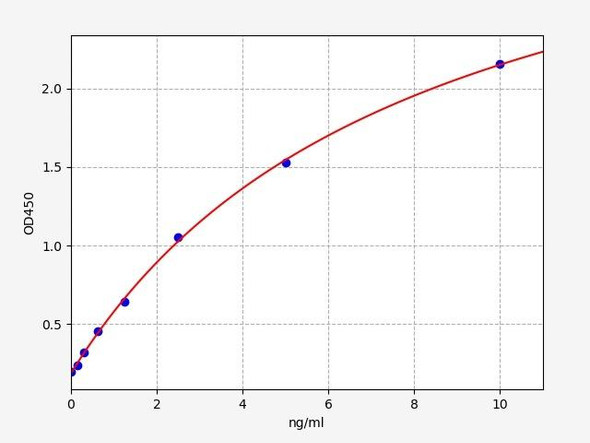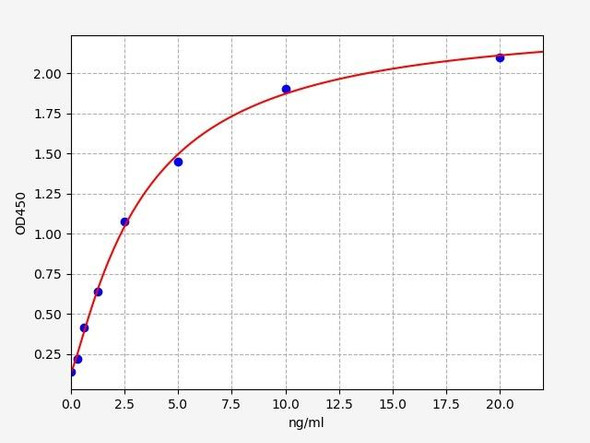Description
Human Axin-1 (AXIN1) ELISA Kit
The Human Axin-1 (Axin1) ELISA Kit is specifically designed for the precise measurement of Axin1 levels in human serum, plasma, and cell culture supernatants. This kit offers exceptional sensitivity and accuracy, guaranteeing dependable and consistent results, making it perfect for various research purposes.Axin1 is a key protein known to regulate the Wnt signaling pathway, which is crucial for controlling cell growth, cell fate determination, and embryonic development.
Dysregulation of the Wnt signaling pathway has been linked to various diseases, including cancer and developmental disorders, highlighting the importance of Axin1 as a biomarker for studying these conditions and exploring potential therapeutic interventions.Order the Human Axin-1 (Axin1) ELISA Kit now to advance your research and gain valuable insights into the role of Axin1 in health and disease.
| Product Name: | Human Axin-1 (AXIN1) ELISA Kit |
| SKU: | HUEB2684 |
| Size: | 96T |
| Target: | Human Axin-1 (AXIN1) |
| Synonyms: | Axis inhibition protein 1, hAxin, AXIN |
| Assay Type: | Sandwich |
| Detection Method: | ELISA |
| Reactivity: | Human |
| Detection Range: | 0.156-10ng/mL |
| Sensitivity: | 0.1ng/mL |
| Intra CV: | 4.8% | ||||||||||||||||||||
| Inter CV: | 8.6% | ||||||||||||||||||||
| Linearity: |
| ||||||||||||||||||||
| Recovery: |
| ||||||||||||||||||||
| Function: | Component of the beta-catenin destruction complex required for regulating CTNNB1 levels through phosphorylation and ubiquitination, and modulating Wnt-signaling. Controls dorsoventral patterning via two opposing effects; down-regulates CTNNB1 to inhibit the Wnt signaling pathway and ventralize embryos, but also dorsalizes embryos by activating a Wnt-independent JNK signaling pathway. In Wnt signaling, probably facilitates the phosphorylation of CTNNB1 and APC by GSK3B. Likely to function as a tumor suppressor. Facilitates the phosphorylation of TP53 by HIPK2 upon ultraviolet irradiation. Enhances TGF-beta signaling by recruiting the RNF111 E3 ubiquitin ligase and promoting the degradation of inhibitory SMAD7. Also component of the AXIN1-HIPK2-TP53 complex which controls cell growth, apoptosis and development. |
| Uniprot: | O15169 |
| Sample Type: | Serum, plasma, tissue homogenates, cell culture supernates and other biological fluids |
| Specificity: | Natural and recombinant human Axin-1 |
| Sub Unit: | Homodimer. Interacts with ZBED3; the interaction is direct, enhanced by protein kinase GSK3B and casein kinase CSNK1E activities and decreases GSK3B-induced beta-catenin serine and threonine phosphorylations (By similarity). Component of the beta-catenin destruction complex, containing at least, CTNNB1, an axin and GSK3B, that regulates CTNNB1 protein levels through phosphorylation and ubiquitination. Interacts with CTNNB1 (via the armadillo repeats 2-7). Interacts with GSK3B; the interaction hyperphosphorylates CTNNB1 leading to its ubiquitination and destruction. Component of the AXIN1-HIPK2-TP53 complex. Interacts directly in the complex with TP53 and HIPK2. Interacts with DAXX; the interaction stimulates the interaction of DAXX with TP53, stimulates 'Ser-46' phosphorylation of TP53 and induces cell death on UV irradiation. Also binds APC, SMAD6, SMAD7 and RNF111. Interacts with DIXDC1; prevents interaction with MAP3K1. Interacts with MAP3K4. Interacts with ANKRD6 and AIDA (By similarity). Interacts with MDFI; the interaction decreases AXIN1-mediated JUN N-terminal kinase (JNK) activation. Interacts with MDFIC; the interaction inhibits beta-cateninin-mediated signaling and AXIN1-mediated JUN N-terminal kinase (JNK) activation. Interacts with LRP5 (via its phosphorylated PPPSP motifs); the interaction is stimulated by WNT1 and GSK3B and activates beta-catenin signaling. Interacts (via the C-terminal) with PPP1CA; the interaction dephosphorylates AXIN1 and regulates interaction with GSK3B. Interacts with PPP2CA; the interaction dephosphorylates AXIN1. Interacts with MACF1 (By similarity). Found in a complex composed of MACF1, APC, AXIN1, CTNNB1 and GSK3B (By similarity). Interacts with TNKS. Interacts with DAB2; the interaction is mutually exclusive with the AXIN1:PPP1CA interaction. |
| Research Area: | Cancer |
| Subcellular Location: | Cytoplasm Nucleus Membrane Cell membrane MACF1 is required for its translocation to cell membrane (By similarity). On UV irradiation, translocates to the nucleus and colocalizes with DAAX (PubMed:17210684). |
| Storage: | Please see kit components below for exact storage details |
| Note: | For research use only |
| UniProt Protein Function: | axin 1: is a negative regulator of the Wnt pathway, which is critical in stem cell signaling, morphogenesis, the mesenchymal-epithelial transition, and many cancers. Axin-1 functions as a tumor suppressor. Probably facilitates the phosphorylation of beta-catenin and APC by GSK3B, leading to their ubiquitination and subsequent proteolysis. Wild-type axin 1 can induce apoptosis in hepatocellular and colorectal cancer cells. Is downregulated during progression of esophageal squamous cell carcinoma. Mutation of the axin-1 gene is associated with hepatocellular carcinoma, anaplastic thyroid cancer, medulloblastoma and colorectal cancer. May have a role in oncogenesis in Hodgkin lymphoma. Axin1/2 mediate cross-talk between TGF-beta and Wnt signaling pathways. |
| UniProt Protein Details: | Protein type:Tumor suppressor; Adaptor/scaffold Chromosomal Location of Human Ortholog: 16p13.3 Cellular Component: Golgi apparatus; perinuclear region of cytoplasm; cytoplasmic microtubule; cytoplasmic membrane-bound vesicle; postsynaptic density; cytoplasm; cell cortex; cytoplasmic vesicle; cytosol; beta-catenin destruction complex; nucleus; lateral plasma membrane Molecular Function:protein C-terminus binding; identical protein binding; protein homodimerization activity; protein self-association; p53 binding; beta-catenin binding; protein kinase binding; GTPase activator activity; signal transducer activity; protein binding; receptor signaling complex scaffold activity; enzyme binding; ubiquitin protein ligase binding; protein complex scaffold; SMAD binding; receptor binding Biological Process: cell death; protein polyubiquitination; negative regulation of Wnt receptor signaling pathway; apoptosis; embryonic eye morphogenesis; positive regulation of transcription, DNA-dependent; positive regulation of JNK cascade; negative regulation of protein metabolic process; dorsal/ventral axis specification; nucleocytoplasmic transport; Wnt receptor signaling pathway through beta-catenin; olfactory placode formation; activation of JNK activity; cytoplasmic microtubule organization and biogenesis; sensory perception of sound; positive regulation of ubiquitin-protein ligase activity; Wnt receptor signaling pathway involved in forebrain neuron fate commitment; protein catabolic process; protein homooligomerization; axial mesoderm formation; in utero embryonic development; positive regulation of transforming growth factor beta receptor signaling pathway; muscle cell development; negative regulation of fat cell differentiation; optic placode formation; positive regulation of peptidyl-serine phosphorylation; cellular protein complex assembly; positive regulation of protein ubiquitination; positive regulation of proteasomal ubiquitin-dependent protein catabolic process; forebrain anterior/posterior pattern formation; activation of protein kinase activity; positive regulation of protein catabolic process; positive regulation of protein amino acid phosphorylation; determination of left/right symmetry; positive regulation of GTPase activity Disease: Caudal Duplication Anomaly; Hepatocellular Carcinoma |
| UniProt Code: | O15169 |
| NCBI GenInfo Identifier: | 27501450 |
| NCBI Gene ID: | 8312 |
| NCBI Accession: | NP_003493.1 |
| UniProt Secondary Accession: | O15169,Q4TT26, Q4TT27, Q86YA7, Q8WVW6, Q96S28, |
| UniProt Related Accession: | O15169 |
| Molecular Weight: | 862 |
| NCBI Full Name: | axin-1 isoform a |
| NCBI Synonym Full Names: | axin 1 |
| NCBI Official Symbol: | AXIN1 |
| NCBI Official Synonym Symbols: | AXIN; PPP1R49 |
| NCBI Protein Information: | axin-1; axis inhibitor 1; fused, mouse, homolog of; axis inhibition protein 1; protein phosphatase 1, regulatory subunit 49 |
| UniProt Protein Name: | Axin-1 |
| UniProt Synonym Protein Names: | Axis inhibition protein 1 |
| Protein Family: | Axin |
| UniProt Gene Name: | AXIN1 |
| UniProt Entry Name: | AXIN1_HUMAN |
| Component | Quantity (96 Assays) | Storage |
| ELISA Microplate (Dismountable) | 8×12 strips | -20°C |
| Lyophilized Standard | 2 | -20°C |
| Sample Diluent | 20ml | -20°C |
| Assay Diluent A | 10mL | -20°C |
| Assay Diluent B | 10mL | -20°C |
| Detection Reagent A | 120µL | -20°C |
| Detection Reagent B | 120µL | -20°C |
| Wash Buffer | 30mL | 4°C |
| Substrate | 10mL | 4°C |
| Stop Solution | 10mL | 4°C |
| Plate Sealer | 5 | - |
Other materials and equipment required:
- Microplate reader with 450 nm wavelength filter
- Multichannel Pipette, Pipette, microcentrifuge tubes and disposable pipette tips
- Incubator
- Deionized or distilled water
- Absorbent paper
- Buffer resevoir
*Note: The below protocol is a sample protocol. Protocols are specific to each batch/lot. For the correct instructions please follow the protocol included in your kit.
Allow all reagents to reach room temperature (Please do not dissolve the reagents at 37°C directly). All the reagents should be mixed thoroughly by gently swirling before pipetting. Avoid foaming. Keep appropriate numbers of strips for 1 experiment and remove extra strips from microtiter plate. Removed strips should be resealed and stored at -20°C until the kits expiry date. Prepare all reagents, working standards and samples as directed in the previous sections. Please predict the concentration before assaying. If values for these are not within the range of the standard curve, users must determine the optimal sample dilutions for their experiments. We recommend running all samples in duplicate.
| Step | |
| 1. | Add Sample: Add 100µL of Standard, Blank, or Sample per well. The blank well is added with Sample diluent. Solutions are added to the bottom of micro ELISA plate well, avoid inside wall touching and foaming as possible. Mix it gently. Cover the plate with sealer we provided. Incubate for 120 minutes at 37°C. |
| 2. | Remove the liquid from each well, don't wash. Add 100µL of Detection Reagent A working solution to each well. Cover with the Plate sealer. Gently tap the plate to ensure thorough mixing. Incubate for 1 hour at 37°C. Note: if Detection Reagent A appears cloudy warm to room temperature until solution is uniform. |
| 3. | Aspirate each well and wash, repeating the process three times. Wash by filling each well with Wash Buffer (approximately 400µL) (a squirt bottle, multi-channel pipette,manifold dispenser or automated washer are needed). Complete removal of liquid at each step is essential. After the last wash, completely remove remaining Wash Buffer by aspirating or decanting. Invert the plate and pat it against thick clean absorbent paper. |
| 4. | Add 100µL of Detection Reagent B working solution to each well. Cover with the Plate sealer. Incubate for 60 minutes at 37°C. |
| 5. | Repeat the wash process for five times as conducted in step 3. |
| 6. | Add 90µL of Substrate Solution to each well. Cover with a new Plate sealer and incubate for 10-20 minutes at 37°C. Protect the plate from light. The reaction time can be shortened or extended according to the actual color change, but this should not exceed more than 30 minutes. When apparent gradient appears in standard wells, user should terminatethe reaction. |
| 7. | Add 50µL of Stop Solution to each well. If color change does not appear uniform, gently tap the plate to ensure thorough mixing. |
| 8. | Determine the optical density (OD value) of each well at once, using a micro-plate reader set to 450 nm. User should open the micro-plate reader in advance, preheat the instrument, and set the testing parameters. |
| 9. | After experiment, store all reagents according to the specified storage temperature respectively until their expiry. |
When carrying out an ELISA assay it is important to prepare your samples in order to achieve the best possible results. Below we have a list of procedures for the preparation of samples for different sample types.
| Sample Type | Protocol |
| Serum | If using serum separator tubes, allow samples to clot for 30 minutes at room temperature. Centrifuge for 10 minutes at 1,000x g. Collect the serum fraction and assay promptly or aliquot and store the samples at -80°C. Avoid multiple freeze-thaw cycles. If serum separator tubes are not being used, allow samples to clot overnight at 2-8°C. Centrifuge for 10 minutes at 1,000x g. Remove serum and assay promptly or aliquot and store the samples at -80°C. Avoid multiple freeze-thaw cycles. |
| Plasma | Collect plasma using EDTA or heparin as an anticoagulant. Centrifuge samples at 4°C for 15 mins at 1000 × g within 30 mins of collection. Collect the plasma fraction and assay promptly or aliquot and store the samples at -80°C. Avoid multiple freeze-thaw cycles. Note: Over haemolysed samples are not suitable for use with this kit. |
| Urine & Cerebrospinal Fluid | Collect the urine (mid-stream) in a sterile container, centrifuge for 20 mins at 2000-3000 rpm. Remove supernatant and assay immediately. If any precipitation is detected, repeat the centrifugation step. A similar protocol can be used for cerebrospinal fluid. |
| Cell culture supernatant | Collect the cell culture media by pipette, followed by centrifugation at 4°C for 20 mins at 1500 rpm. Collect the clear supernatant and assay immediately. |
| Cell lysates | Solubilize cells in lysis buffer and allow to sit on ice for 30 minutes. Centrifuge tubes at 14,000 x g for 5 minutes to remove insoluble material. Aliquot the supernatant into a new tube and discard the remaining whole cell extract. Quantify total protein concentration using a total protein assay. Assay immediately or aliquot and store at ≤ -20 °C. |
| Tissue homogenates | The preparation of tissue homogenates will vary depending upon tissue type. Rinse tissue with 1X PBS to remove excess blood & homogenize in 20ml of 1X PBS (including protease inhibitors) and store overnight at ≤ -20°C. Two freeze-thaw cycles are required to break the cell membranes. To further disrupt the cell membranes you can sonicate the samples. Centrifuge homogenates for 5 mins at 5000xg. Remove the supernatant and assay immediately or aliquot and store at -20°C or -80°C. |
| Tissue lysates | Rinse tissue with PBS, cut into 1-2 mm pieces, and homogenize with a tissue homogenizer in PBS. Add an equal volume of RIPA buffer containing protease inhibitors and lyse tissues at room temperature for 30 minutes with gentle agitation. Centrifuge to remove debris. Quantify total protein concentration using a total protein assay. Assay immediately or aliquot and store at ≤ -20 °C. |
| Breast Milk | Collect milk samples and centrifuge at 10,000 x g for 60 min at 4°C. Aliquot the supernatant and assay. For long term use, store samples at -80°C. Minimize freeze/thaw cycles. |







